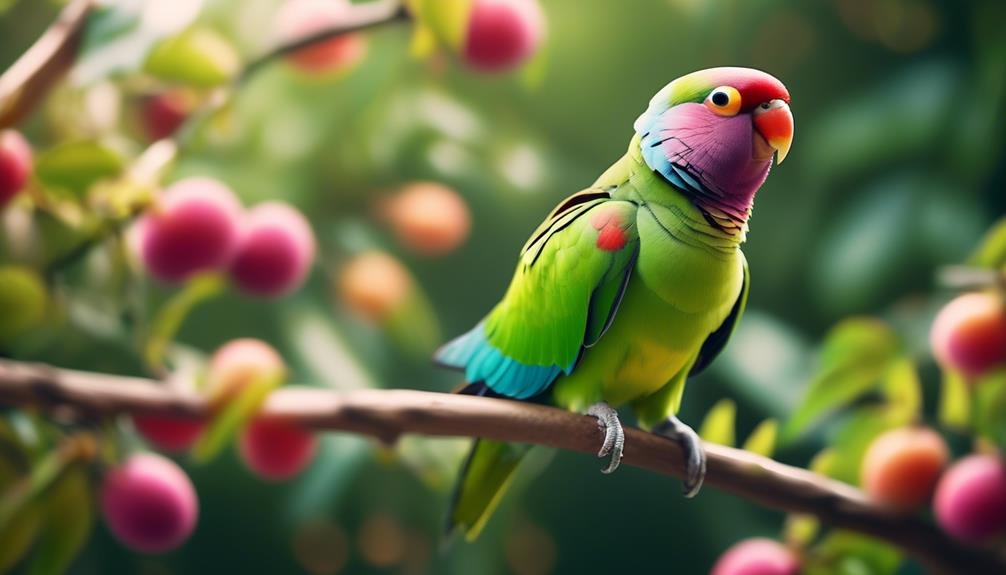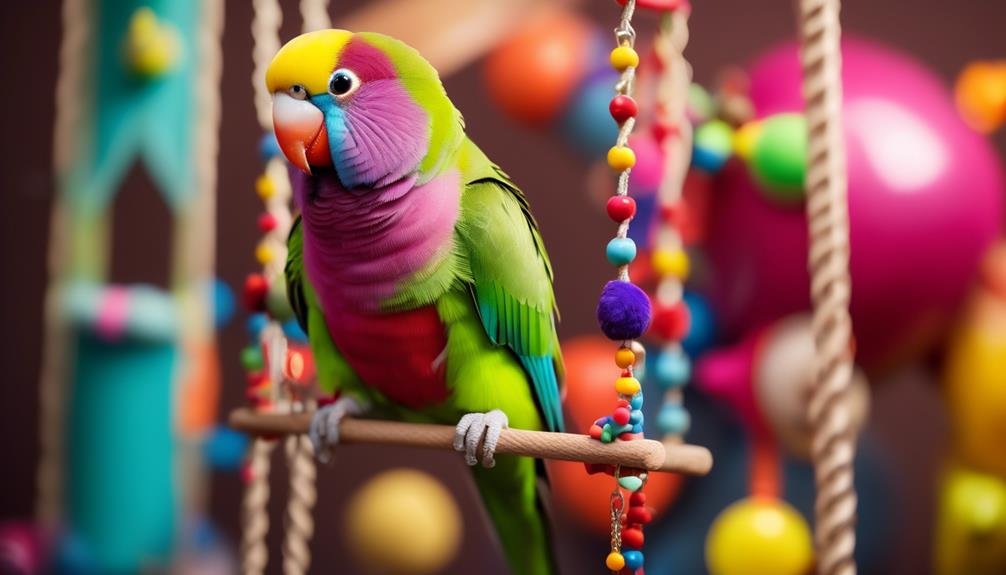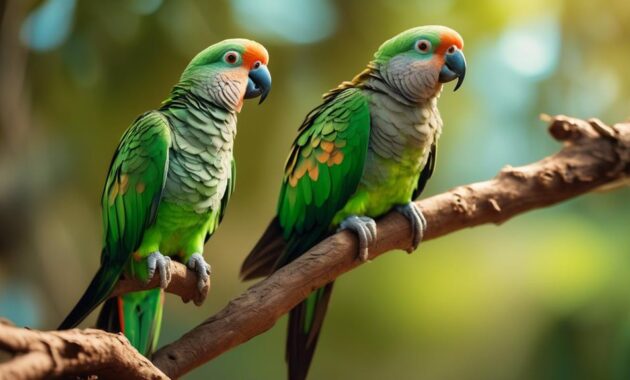
Looking to add a burst of color and playfulness to your life? The Plum Headed Parakeet is the perfect choice. With its vibrant green feathers, splashed with hints of red and grey, this bird is a living work of art. But its beauty is only the beginning of what makes it so captivating.
From its energetic nature to its playful antics, the Plum Headed Parakeet is a companion like no other. So, if you're ready to discover more about this remarkable bird and unlock the secrets of its charm, join us on this journey.
You won't want to miss what's in store.
Key Takeaways
- Plum Headed Parakeets are a medium-sized parakeet species with a vibrant green plumage and red and grey details.
- They are highly social and form strong bonds with their mates, making them playful and affectionate companions.
- These parakeets are vocal communicators and can mimic some basic sounds or words.
- They have a long lifespan of up to 30 years and require ample space for free flight and exercise.
Size and Physical Characteristics
The Plum Headed Parakeet is a medium-sized bird, measuring an average length of 13 inches. With a tail length that can reach up to 9 inches, it's comparable in size to other parakeets.
This vibrant and playful bird requires ample space for free flight and exercise, as it's known for its energetic nature. Proper care and attention are necessary for its long lifespan, which can be up to 30 years. Diet and living conditions can influence its lifespan, so regular veterinary check-ups are recommended.
As a member of the parakeet family, the Plum Headed Parakeet is widely known and popular as a pet bird. Its predominantly green plumage, with red and grey details, gives it a vibrant and eye-catching appearance.
Lifespan and Care

To ensure the long and healthy lifespan of your Plum Headed Parakeet, proper care and attention are essential.
These vibrant and playful birds can live up to 30 years, which is longer than many other bird species.
To promote a healthy life for your parakeet, it's important to provide a balanced diet and suitable living conditions.
Regular veterinary check-ups are also recommended to monitor their health and address any potential issues.
Additionally, giving your Plum Headed Parakeet plenty of exercise and mental stimulation is crucial.
They require ample space for free flight and enjoy toys and activities that keep them engaged.
Bird Species

Plum Headed Parakeet, widely known as a popular pet bird, belongs to the parakeet family. This species shares similarities with other parakeet breeds and is known for its vibrant colors and playful nature. Found in various regions of the Indian subcontinent, these parakeets have a predominantly green plumage with red and grey details. Their appearance is vibrant and eye-catching, with slight variations in coloration among individuals.
In terms of vocalizations, Plum Headed Parakeets have natural calls and can mimic some basic sounds or words. They're known to be noisy and energetic in their vocalizations, with moderate noise levels. If you're considering a pet bird, the Plum Headed Parakeet is a great choice due to its beauty and playful personality.
Colors and Appearance

When it comes to the Plum Headed Parakeet, one cannot help but be captivated by its vibrant colors and striking appearance. This parakeet is predominantly green in color, with red and grey details present on its plumage. Its vibrant and eye-catching appearance makes it a beautiful addition to any bird enthusiast's collection. The coloration of the Plum Headed Parakeet may vary slightly among individuals, and their feathers may even change color slightly with age. To give you a better idea of the Plum Headed Parakeet's colors and appearance, here is a table highlighting its distinct features:
| Color | Description |
|---|---|
| Predominantly Green | The base color of the Plum Headed Parakeet's plumage. |
| Red Details | Red patches or markings can be found on the head, wings, or tail. |
| Grey Details | Grey highlights can be seen on the neck or back of the parakeet. |
| Vibrant Appearance | The combination of green, red, and grey creates a visually striking bird. |
With its colorful plumage, the Plum Headed Parakeet is truly a sight to behold.
Sounds and Vocalizations

The Plum Headed Parakeet is known for its lively and expressive vocalizations. This energetic bird has a variety of natural calls and can even learn to mimic some basic sounds or words. While they aren't as loud as some other parakeet species, their vocalizations can still be quite noisy and energetic.
They're known for their natural twittering and shrill calls, which add to their vibrant and playful nature. The Plum Headed Parakeet's vocal abilities make them a lively and engaging pet bird.
Habitat and Natural Environment

To understand the natural habitat and environment of the Plum Headed Parakeet, it's important to consider the regions in which they're commonly found. Here are three key points to help you understand their habitat and natural environment:
- Native to the Indian subcontinent: The Plum Headed Parakeet is found in various regions of the Indian subcontinent, including India, Sri Lanka, and Nepal. They inhabit both forested areas and open landscapes.
- Forest dwellers: These parakeets prefer to live in forests and wooded areas, where they can find plenty of trees for nesting and roosting. They're also known to inhabit gardens, orchards, and agricultural fields.
- Urban adaptability: Plum Headed Parakeets have successfully adapted to urban environments and can be found in cities and towns. They're often seen in parks, gardens, and even residential areas, where they find food and nesting sites.
Diet and Feeding Habits

Plum Headed Parakeets have diverse dietary preferences that contribute to their overall health and well-being. These colorful birds primarily feed on fruits, berries, and seeds, making them frugivorous in nature. Their diet also includes a variety of nuts, flowers, and leafy greens. In the wild, they forage for food in trees and shrubs, using their strong beaks to crack open seeds and extract the nutritious contents.
As pets, they should be provided with a balanced diet that consists of high-quality parakeet pellets, fresh fruits, and vegetables. It's important to ensure that their diet is rich in vitamins and minerals to support their growth and maintain their vibrant plumage.
Additionally, Plum Headed Parakeets require access to fresh water at all times to stay hydrated and healthy.
Social Behavior and Interaction

After discussing the Plum Headed Parakeet's dietary preferences and feeding habits, let's now explore their social behavior and interaction.
- Highly social creatures: Plum Headed Parakeets are known for their social nature and enjoy being part of a flock. They thrive in the company of other birds and form strong bonds with their mates.
- Playful and affectionate: These parakeets aren't only social but also exhibit playful behavior. They love interacting with their owners and enjoy games and toys that stimulate their active minds.
- Vocal communicators: Plum Headed Parakeets are known for their vocal abilities. They use a variety of calls and sounds to communicate with each other and their human companions. Their natural twittering and shrill calls are common, and they can even learn to mimic basic sounds or words.
These social and playful birds make wonderful companions and can bring joy and entertainment to any household.
Breeding and Reproduction

Breeding and reproduction in Plum Headed Parakeets is a fascinating process that showcases their natural instincts and reproductive behaviors. These birds typically reach sexual maturity at around 2 years of age. Breeding pairs form strong bonds and engage in courtship displays, such as feeding each other and performing aerial acrobatics. The female parakeet lays an average of 3 to 4 eggs in a nest made of wood chips, leaves, and feathers. Both parents take turns incubating the eggs for about 23 to 24 days. Once hatched, the chicks are initially cared for by the female, while the male provides food. The young parakeets fledge after about 35 to 40 days and become independent after a few months. It is important to provide a safe and comfortable environment for breeding pairs, as well as a varied diet to support their reproductive success.
| Breeding and Reproduction | |
|---|---|
| Sexual maturity | Around 2 years of age |
| Number of eggs laid | 3 to 4 |
| Incubation period | 23 to 24 days |
Tips for Pet Owners

As a pet owner of Plum Headed Parakeets, it's important to be aware of some helpful tips to ensure the well-being and happiness of your feathered friends.
Here are three essential tips for taking care of your Plum Headed Parakeets:
- Provide ample space for free flight: These energetic birds require plenty of room to stretch their wings and exercise. Make sure to provide a spacious and secure environment for them to fly and explore.
- Maintain a balanced and nutritious diet: Feed your Plum Headed Parakeets a well-rounded diet consisting of fresh fruits, vegetables, seeds, and pellets. Avoid feeding them foods that are toxic to birds, such as avocado and chocolate.
- Offer mental and physical stimulation: Keep your parakeets entertained and engaged by providing toys, perches, and puzzles. These intelligent birds thrive on mental stimulation and physical activity, so make sure to rotate their toys regularly and provide opportunities for social interaction.
Frequently Asked Questions
Are Plum Headed Parakeets Good for First-Time Bird Owners?
Yes, plum headed parakeets are a good choice for first-time bird owners. They are vibrant and playful, making them entertaining companions. With proper care and attention, they can live up to 30 years.
Can Plum Headed Parakeets Be Trained to Talk?
Yes, plum headed parakeets can be trained to talk. With patience and consistent training, they can learn to mimic basic sounds or words. Their vocal abilities make them an entertaining pet.
How Do Plum Headed Parakeets Interact With Other Bird Species?
Plum Headed Parakeets are social birds that can interact well with other bird species. They enjoy companionship and can form bonds with birds of similar size and temperament. Proper introductions and supervised interaction are important for their well-being.
What Is the Average Price Range for a Plum Headed Parakeet?
The average price range for a plum headed parakeet varies depending on factors such as age, gender, and location. It is recommended to check with local pet stores or breeders for specific pricing information.
Do Plum Headed Parakeets Need a Special Diet Compared to Other Parakeet Breeds?
No, plum-headed parakeets do not need a special diet compared to other parakeet breeds. They require a balanced diet consisting of seeds, fruits, vegetables, and occasional treats to maintain their health and well-being.
Are Plum Headed Parakeets Good Pets for Teaching Tricks Like Lovebirds?
Plum-headed parakeets can make great pets for teaching tricks, much like vibrant peach-faced lovebirds. They are intelligent, social, and easily trainable. With patience and positive reinforcement, they can learn to perform a variety of tricks and can provide hours of entertainment for their owners.
Conclusion
In conclusion, the Plum Headed Parakeet is a truly captivating bird that brings color, joy, and melodious songs into our lives. With its stunning green plumage and playful nature, it's an enchanting companion.
Understanding its size, physical characteristics, and care requirements is essential for ensuring its longevity. Whether as a pet or in its natural habitat, the Plum Headed Parakeet continues to mesmerize and delight bird enthusiasts worldwide.
So why wait? Embark on this exciting journey of discovery and let the Plum Headed Parakeet brighten up your world.




